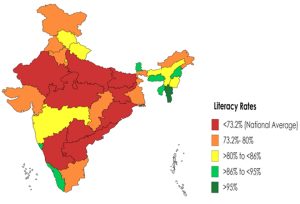88 Global News Post 2
Emily Potter
https://www.orfonline.org/research/literacy-in-india-the-gender-and-age-dimension-57150/ by Tanushree Chandra

(State-wise adult literacy performance in India)
With technological advances, access to information online has become more accessible than ever. Yet, some countries in the global south, such as India have high populations of illiterate adults. In the article, Literacy in India: The Gender and Age Dimension, Tanushree Chandra explains how the gender gap in India plays an immense role in literacy. Chandra mentions that illiteracy has decreased although there is still a large number of illiterate adults, most of whom are women; 313 million. There are multiple social, economic, and cultural factors explaining the gender gap. She describes the large cost of schooling for women and the social restrictions on women preventing them in the workforce. To explain the gap better she thinks it’s important to take age into consideration. With data, Chandra shows that larger gender gaps in literacy occur between older people, while the gap for children is nonexistent. She believes that this is evidence to show that putting more girls in school, as there has been, will closely illuminate the gender gap and illiteracy in India overall.
Tanushree Chandra is from India and works for the Government of India. She has done evidence-based research on the economics of climate change and gender. Chandra’s point of view is ethical as someone in the workforce in India who has studied gender gaps and the economy there. Although she explains the reasoning of the gender gap in literacy is affected by only the number of girls in school. She also shows this through data, yet Chandra leaves out what other factors there could be. Additionally, Chandra’s solution is to put more girls into schools but doesn’t explain how social and economic issues can be solved to do so. The evidence Chandra uses explains that there is an issue between illiterate adults. So the perspective of someone in the education system who can explain the social-gender difference in India would be beneficial.
References
Tanushree Chandra, “Literacy in India: The Gender and Age Dimension”, ORF Issue Brief No. 322, October 2019, Observer Research Foundation.